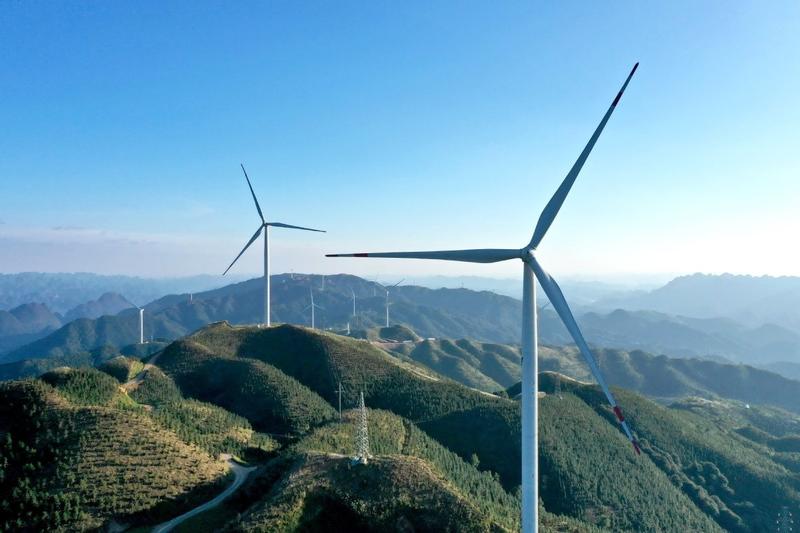 This undated file photo shows an aerial view of a wind farm in Liuzhou, Guangxi Zhuang autonomous region. (PHOTO BY TAN KAIXING / FOR CHINA DAILY)
This undated file photo shows an aerial view of a wind farm in Liuzhou, Guangxi Zhuang autonomous region. (PHOTO BY TAN KAIXING / FOR CHINA DAILY)
BEIJING-The ongoing global health emergency has propelled the world to take further strides toward a green revolution.
China has announced that it will be increasingly embracing green and inclusive development, with a raft of eco-friendly measures taken amid its V-shaped recovery.
The country has also vowed to strive to bring carbon emissions to a peak before 2030 and become carbon-neutral before 2060.
In announcing such measures, China is not simply paying lip service to environmental concerns.
A report published last month by global rating agency Moody's showed that China, along with wealthier countries, took the lead in spending on green recovery in the Asia-Pacific region.
Coal-fired power remains a major energy source in China, which has long pursued clean power and has become the world's largest producer and user of renewable energy.
According to a Deutsche Bank report, by 2030, China is expected to see its output of solar power increase tenfold, while that of wind power will be three or four times the level of 2020
During the post-contagion recovery, the country has introduced a series of green stimulus measures, and has seen a surge in the installed capacity of clean energy.
In the fourth quarter, installed capacity of photovoltaics in China reached 29.5 million kilowatts, while that of wind power increased by 57.75 million kW, both far exceeding the combined installed capacity in the first three quarters, said the National Energy Administration.
China's clean-energy consumption accounted for 24.5 percent of total energy consumption in 2020, up 1.1 percentage points compared with that in 2019, the NEA said.
According to a Deutsche Bank report, by 2030, China is expected to see its output of solar power increase tenfold, while that of wind power will be three or four times the level of 2020.
Green energy has shown great market potential, with the country promising to bring its total installed capacity of wind and solar power to over 1.2 billion kW by 2030.
Qian Zhimin, chairman of State Power Investment Corp, predicted that newly installed capacity for these two kinds of clean energy will require over 12 trillion yuan (US$1.85 trillion) of investment by 2030.
On Monday, China began implementing a set of interim rules for the management of carbon-emissions trading designed to drive down emissions of big power users.
ALSO READ: Ensuring resource-saving economy during 14th Five-Year Plan period
Under the scheme, firms that exceed emission caps can buy emission quotas from others with a lower carbon footprint.
A total of 2,225 power firms are included in the project. More fields, such as the steel and aluminum production sectors, will be included in future carbon trading.
Global market players have already seen opportunities in China's green ambitions.
EN+ Group, a global producer of low-carbon aluminum, has teamed up with a Chinese counterpart to produce the base metal, reflecting surging demand for greener products and materials in China.
"Considering that China is set to see further substantial economic growth in 2021, the country will remain the biggest global primary aluminum market," said Lord Barker, chairman of EN+ Group.
The group will continue expanding its business in China and cooperate with its Chinese partners to research and develop new high-quality low-carbon products, he said.
Suez Group, a global expert in the water and waste treatment sectors, also regards China's carbon-neutrality pledge as a great opportunity for the company's development in the country.
The Chinese market accounted for 10 percent of the company's business worldwide, and the share is increasing, said Steve Clark, CEO of Suez Asia.
As the entire country moves toward a carbon-neutral pledge, "if there is any country in the world that can actually achieve the climate ambition, it's China," Chen said.
To facilitate clean-energy projects and many others, China should further leverage green financing for a sustainable recovery, analysts said.
In July 2020, a national green-development fund company, with a total registered capital of 88.5 billion yuan, was put into operation to raise funds for green projects.
The country's central bank also vowed to step up financial support for green development, focusing on developing green-finance products and strengthening international cooperation.
By the end of 2020, the country's balance of gren loans had far exceeded 11 trillion yuan, the largest worldwide, while outstanding loans of green bonds stood at over 1 trillion yuan, according to Yi Gang, governor of the People's Bank of China, the central bank.
However, the market is still thirsting for more funds.
To achieve carbon neutrality by 2060, China needs to invest about 100 trillion yuan in green projects over the next 40 years, according to an estimate from Tsinghua University cited in the Deutsche Bank report.
READ MORE: Carbon neutrality to cost 100 trillion yuan
The report calls for strengthening monetary and fiscal incentives for green investment, developing a comprehensive green-finance structure and improving secondary-market liquidity for green-finance products in the country.


